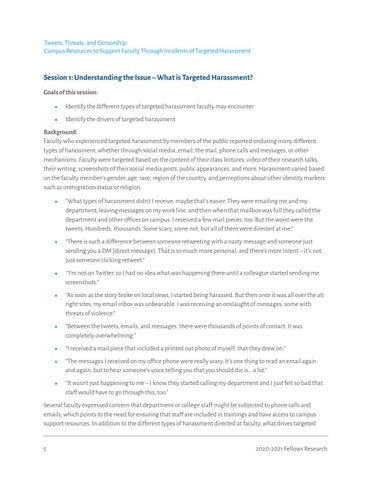Tweets, Threats, and Censorship: Campus Resources to Support Faculty Through Incidents of Targeted Harassment
Session 1: Understanding the Issue – What is Targeted Harassment? Goals of this session: ●
Identify the different types of targeted harassment faculty may encounter
●
Identify the drivers of targeted harassment
Background: Faculty who experienced targeted harassment by members of the public reported enduring many different types of harassment, whether through social media, email, the mail, phone calls and messages, or other mechanisms. Faculty were targeted based on the content of their class lectures, video of their research talks, their writing, screenshots of their social media posts, public appearances, and more. Harassment varied based on the faculty member’s gender, age, race, region of the country, and perceptions about other identity markers such as immigration status or religion. ●
“What types of harassment didn’t I receive, maybe that’s easier. They were emailing me and my department, leaving messages on my work line, and then when that mailbox was full they called the department and other offices on campus. I received a few mail pieces, too. But the worst were the tweets. Hundreds, thousands. Some scary, some not, but all of them were directed at me.”
●
“There is such a difference between someone retweeting with a nasty message and someone just sending you a DM [direct message]. That is so much more personal, and there’s more intent – it’s not just someone clicking retweet.”
●
“I’m not on Twitter, so I had no idea what was happening there until a colleague started sending me screenshots.”
●
“As soon as the story broke on local news, I started being harassed. But then once it was all over the alt right sites, my email inbox was unbearable. I was receiving an onslaught of messages, some with threats of violence.”
●
“Between the tweets, emails, and messages, there were thousands of points of contact. It was completely overwhelming.”
●
“I received a mail piece that included a printed out photo of myself, that they drew on.”
●
“The messages I received on my office phone were really scary. It’s one thing to read an email again and again, but to hear someone’s voice telling you that you should die is… a lot.”
●
“It wasn’t just happening to me – I know they started calling my department and I just felt so bad that staff would have to go through this, too.”
Several faculty expressed concern that department or college staff might be subjected to phone calls and emails, which points to the need for ensuring that staff are included in trainings and have access to campus support resources. In addition to the different types of harassment directed at faculty, what drives targeted
5
2020-2021 Fellows Research


